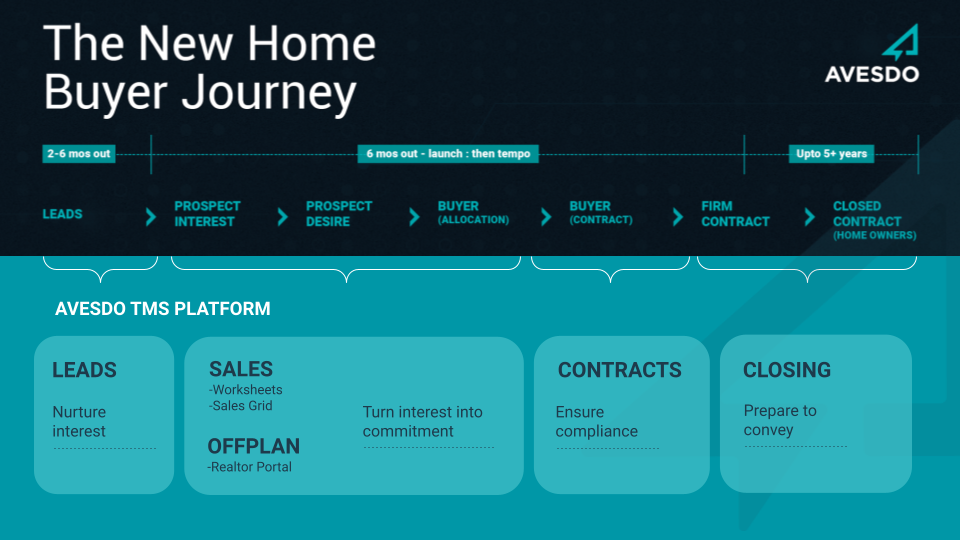The “going in-house” conundrum.
Written by Ben Smith
So you’re thinking about building an in-house software system to manage your sales and marketing efforts and using your Enterprise Resource Planning (ERP) system to integrate those efforts into other departments. Whether you’re contemplating this decision, knee-deep and struggling, or if you’re fully completed and reassessing, this article is for you.
My expertise on this question comes from having done it a few times. The first was in 2008 when I was VP of Marketing at a Tier 1 Developer. Since then, I have worked on a few projects for other developers.
For full disclosure, I’m currently the president of Avesdo Technologies. While I’m committed to our platform and its success, this paper isn’t meant to sell you anything. Rather, this paper is about sharing lessons learned from my experience and offering considerations and advice for tackling the “in-house software beast.”
For simplicity, I will break this paper into a few sections.
What problem are you trying to solve? What are you hoping to gain from the exercise?
In 2008, we took on the task of a build and implementation because our current systems were largely paper-based and clumsy. The system needed significant work to audit accuracy (because the human error was also high), and to pull any data for reporting, analysis, and debriefing. It resulted in a number of work-arounds and spreadsheets that were not standardized and were lost in the shuffle of employee turnover. We wanted to solve this.
We also wanted the benefits of digitization:
- Real-time data visibility across all projects,
- The ability to automate several processes to reduce staffing requirements, and
- Better exposure to demand for revenue optimization and cost management within sales and marketing.
We achieved our goal and built a great system. I understand they have continued to invest in, improve on, and still use this system today.
In this first experience, the only “system” we had was an older in-house system that wasn’t performing. In more recent exercises, I was moving companies away from industry-specific apps and software (like Avesdo) and onto their own in-house system. Yes, not only am I the President, but I was also a client. Many of the items listed above were being covered by the patchwork of apps and software being used, so in these instances the goals were different.
The main goals weren’t to duplicate the systems already being used, but to try merging them into a single platform in hopes of cost savings, and/or to be able to fully customize to our internal needs and ways of doing things, as well as better integration with other systems in the company.
There are likely a myriad of other reasons, but for this paper we’ll assume most fall into one of the two narratives I just described.
Options to solve your problems?
So looking at the two scenarios above, the options are fairly clear.
- Work with a major player then bring in a third-party implementation group to customize to fit the new home space and your company’s unique ways of doing things; or
- Use a series of vertical-specific apps and software to cover off the various pieces of workflow you need to address.
Let’s tackle the two solutions first.
Option 1 — CRM + bolt-ons for reporting
This is arguably the obvious solution and one I have personally believed in and pursued on many occasions. I have spent the money, and I now hope to educate you on the pros, cons and true costs associated.
Let’s start off by discussing what’s involved.
Base system: In most cases this option requires you to license the base software through a CRM or other provider. Generally this will be done via a subscription model which includes user license costs, and then costs for any add-on modules, storage, etc. You will pay this yearly for eternity.
Implementation partner: Once you have the base software selected and turned on, you then need someone to customize it to fit the new home industry and your specific requirements. These big systems do not work for our industry out of the box and at their core are usually CRMs – Customer Relationship Managers – so the contracting, inventory management, payment collection, etc. all need to be incorporated and customized. With larger players, there are loads of apps and bolt-ons. However, I can tell you from experience that none of them work perfectly (or even well) within the new home industry, and all need to be configured at the very least, and more likely fully customized.
You’ll assume that, once you have spent the money to “build” the system, this cost goes away. It surely does not. You will be left with a fully customized system, and you will need someone to work on your unique customized system until the end of time. The bill will not be as big as the first one, but it will be ongoing and yearly.
In-house experts: Taking on this project means you’ll need in-house people to manage the solution. It can’t just be your “techy marketing guy” or your IT hardware guy; you’ll need real specialists.
In my experience, the team requires a minimum of two people – one switched on senior to steer strategy along with one junior to support – to as many as 5+, including a CTO, front and backend developers, etc. The larger teams usually get built up to offset the need for implementation partners and shift some of those costs in-house. Either way, you now have a full headcount being added to support your software project.
If you have been doing the math, you can see that the costs are substantial and ongoing. With software, there is no such thing as one-and-done. The initial cost will be high, but the ongoing costs remain substantial.
Pros:
- Fully customized system to your unique workflows and ways of looking at things
- Does everything you are willing to pay for it to do
- In-house team to service (for those that build a team)
Cons:
- Expensive to build and to maintain as you are now maintaining a custom platform
- Still doesn’t do all things the best and often not as well as the specialized systems
- No ability to benefit from updates designed to address industry-specific needs – everyone using it makes and pays for their own updates to their own custom platforms
- Updates done by the vendor can sometimes create issues in your custom workflows
- You are now in the software business
Option 2 — Vertical specific apps and software
The second option is to go with specialized software and apps that are built specific to the new home industry (full disclosure: this is where Avesdo fits in).
These systems are built to address specific workflows within the new home development business and to work off-the-shelf without customization. On the flip side, they usually do not allow much customization, if any. They shouldn’t need it other than to address unique company-specific requirements. Varying levels of integration and APIs are available to connect one system to the next. Each system is going to cost money yearly and be charged either on a subscription or a transactional basis.
Some firms are starting to hire in-house experts to coordinate integrations among the different apps while managing data warehousing or data visualization platforms, but it’s not necessary.
Pros:
- Customized to industry-specific workflows out of the box
- Little to no upfront set-up required
- Vendor companies are built around a single process so usually perform it far better than a generalized system customized to do the same thing
- Industry collectively bares the cost of industry-wide updates
Cons:
- More expensive than one solution (although arguably not when considering all costs)
- Limited customizations
- Multiple platforms are seen as less desirable than a single source
The real truth.
After significant experience on the topic, I would urge eager in-housers to seriously weigh the pros and cons. Here are some unintended consequences from venturing out into your own system.
- Despite everyone’s best efforts, I have yet to meet a developer who saved money by bringing software in-house. It always becomes a massive multi-year / forever investment to build and maintain.
- The investment becomes the reason to keep trying to fix it rather than the main reason for doing it which was to make things more efficient and provide valuable business systems.
- The cost to get an in-house system to function as effectively as a specialized solution will never pencil and very few even get there before giving up, or their capital expenditure gets cut and they have to just deal with what they have.
- Your in-house “software department” will never be as good, fast, and productive as an entire “software company.” It’s just not your core business.
- Your in-house system becomes competition with other software companies rather than giving you a competitive advantage over your real competitors which are other new home developers and sellers.
- Your data is not any more secure, or any more “yours,” as all data is now stored in the cloud and largely in the same places.
- Once you create an in-house team there is motivation to want to keep fixing the thing that gives their job purpose. So are you ever really going to get an honest assessment of the value of the system you’ve built? Developer tech teams should continue reading — you still have a super important job, as I’ll explain in a minute.
My honest recommendations:
I’m going to speak specifically to the large companies who can afford the capital expenditure of a big build, yearly running costs, and an in-house team, but the principles apply to anyone wanting to take on an in-house build, everything will just be scaled back to fit your size.
I would suggest you start by reframing the problem you need to solve. As stated already, you should let go of the cost side of the equation as an in-house solution will not save you anything. Also, you should realize that spending millions to customize a system and process that your competitors can buy off the shelf is giving you no advantage. Instead, I would suggest that the most valuable problem you can solve is to ensure that:
- You have the best and most customized visibility into your own data,
- You own that data, and
- Whatever system you decide on is fully adopted throughout the organization.
So, if this is the core problem to solve, it doesn’t make sense to custom-build software and processes. It makes more sense to use industry-specific or specialized software and processes, then spend your internal efforts on ensuring the data you are capturing is shared across the systems that need it and spit back to your teams in a way that they can use the data for decisions.
How do you do this? These key steps show the way.
First, establish which off-the-shelf software is the best solution for the greatest number of steps in the buyer journey that matter to you. You may wish to find a great CRM to manage the lead portion of the puzzle. Maybe you need one with more horsepower because your sales team also uses it to manage leads; or maybe you just need a great mass email system and light lead tracker because only your marketing team uses it. Next is your selections worksheet apps and systems, inventory management, contract management, and POS system. Avesdo is the industry leader but look at our competitors and make the choice, there are a few of us doing all or pieces of these sales processes. Finally, consider your closing and warranty systems.

Once you have a matrix for who fulfills your needs best for each piece, look at the data you require from each system and assess what needs to be shared between systems, and what just needs to be pulled out for management and reporting purposes.
This is where your in-house tech teams come in and are very valuable (I told you there was still a purpose for you). Their role now is to be the ones talking to the software companies — one tech person to another. They are also there to help you integrate the systems and deal with the data. My recommendation is to stop trying to wrangle your process into a single platform, but to look to a single platform for your data that all your process systems can feed into.
Your tech team should help you assess the extent of integration required. Spoiler alert: very little of what is requested of us from our API is ever used or even accessed by users. Remember, every role in your organization usually only needs to log in to the system for the parts that work for them. The executives need only the high-level view, often just the reports, and they usually never log in.
Some of our developer clients doing this the best are creating data warehouses or using data aggregators and pulling data from all systems into one location and then using APIs to push and pull where it’s needed. They are then using visualization tools to create single-source dashboards and reports. They are able to use the software that best performs the function they need it to, and their investment in customizations allows them to optimize their data and associated decision-making. They have not rendered themselves weak competitors to a number of software companies, but instead have created competitive advantage versus their real new home developer competition.
Now that you have your process running smoothly with the best solutions for each step in the process, and you have a single source pushing and pulling data around, your team just needs to focus on training. Every software company you deal with will likely offer training. Take advantage of it. Make your administrators power users of the software they use daily and ensure someone on your team knows a little bit about all of them and how they all fit together.
The majority of tickets our customer success team receives are discovered to be human error. These errors are easily solved with education. Regardless of which system you are investing in, you are not getting the full value from it unless your people know how to use it.
Summary:
- Don’t become a competitor to the software industry by ensuring your tech stack makes you competitive in the new home development industry.
- Single platform work processes are not that valuable given each department really only ever logs into their own part of the process. Invest in the software that does the process best for your needs.
- If you want to invest in custom software, customize around your data sets using data warehouse solutions and visualization platforms.
- Invest in training to ensure your software investment is realized.
Use these key lessons and insights to:
- Start a discussion among your teams and managers,
- Build a comprehensive decision document that outlines the key considerations, and
- Develop a plan for the way forward.
This approach will ensure you are armed with the insights required to make this important decision for your company.
To learn more, connect with one of our sales advisors to help you plan what’s right for your business.




